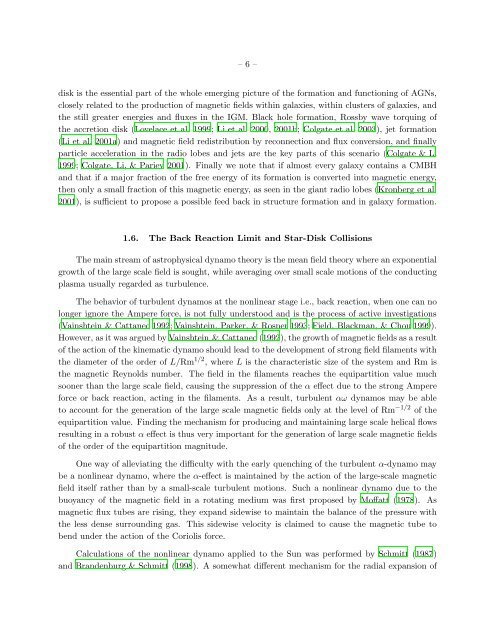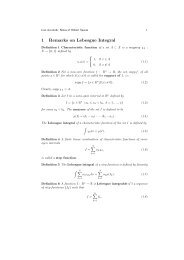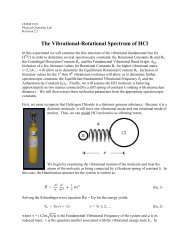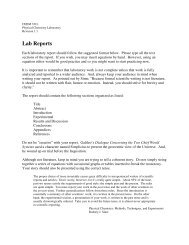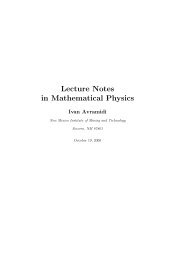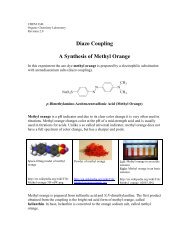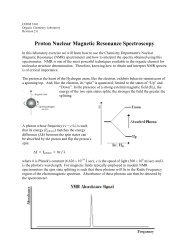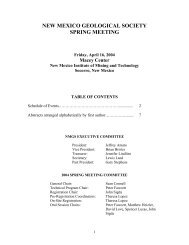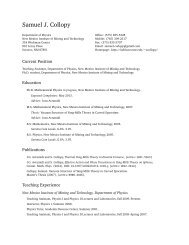A Magnetic α Ï Dynamo in Active Galactic Nuclei Disks - NMT Physics
A Magnetic α Ï Dynamo in Active Galactic Nuclei Disks - NMT Physics
A Magnetic α Ï Dynamo in Active Galactic Nuclei Disks - NMT Physics
Create successful ePaper yourself
Turn your PDF publications into a flip-book with our unique Google optimized e-Paper software.
– 6 –disk is the essential part of the whole emerg<strong>in</strong>g picture of the formation and function<strong>in</strong>g of AGNs,closely related to the production of magnetic fields with<strong>in</strong> galaxies, with<strong>in</strong> clusters of galaxies, andthe still greater energies and fluxes <strong>in</strong> the IGM. Black hole formation, Rossby wave torqu<strong>in</strong>g ofthe accretion disk (Lovelace et al. 1999; Li et al. 2000, 2001b; Colgate et al. 2003), jet formation(Li et al. 2001a) and magnetic field redistribution by reconnection and flux conversion, and f<strong>in</strong>allyparticle acceleration <strong>in</strong> the radio lobes and jets are the key parts of this scenario (Colgate & Li1999; Colgate, Li, & Pariev 2001). F<strong>in</strong>ally we note that if almost every galaxy conta<strong>in</strong>s a CMBHand that if a major fraction of the free energy of its formation is converted <strong>in</strong>to magnetic energy,then only a small fraction of this magnetic energy, as seen <strong>in</strong> the giant radio lobes (Kronberg et al.2001), is sufficient to propose a possible feed back <strong>in</strong> structure formation and <strong>in</strong> galaxy formation.1.6. The Back Reaction Limit and Star-Disk CollisionsThe ma<strong>in</strong> stream of astrophysical dynamo theory is the mean field theory where an exponentialgrowth of the large scale field is sought, while averag<strong>in</strong>g over small scale motions of the conduct<strong>in</strong>gplasma usually regarded as turbulence.The behavior of turbulent dynamos at the nonl<strong>in</strong>ear stage i.e., back reaction, when one can nolonger ignore the Ampere force, is not fully understood and is the process of active <strong>in</strong>vestigations(Va<strong>in</strong>shte<strong>in</strong> & Cattaneo 1992; Va<strong>in</strong>shte<strong>in</strong>, Parker, & Rosner 1993; Field, Blackman, & Chou 1999).However, as it was argued by Va<strong>in</strong>shte<strong>in</strong> & Cattaneo (1992), the growth of magnetic fields as a resultof the action of the k<strong>in</strong>ematic dynamo should lead to the development of strong field filaments withthe diameter of the order of L/Rm 1/2 , where L is the characteristic size of the system and Rm isthe magnetic Reynolds number. The field <strong>in</strong> the filaments reaches the equipartition value muchsooner than the large scale field, caus<strong>in</strong>g the suppression of the α effect due to the strong Ampereforce or back reaction, act<strong>in</strong>g <strong>in</strong> the filaments. As a result, turbulent αω dynamos may be ableto account for the generation of the large scale magnetic fields only at the level of Rm −1/2 of theequipartition value. F<strong>in</strong>d<strong>in</strong>g the mechanism for produc<strong>in</strong>g and ma<strong>in</strong>ta<strong>in</strong><strong>in</strong>g large scale helical flowsresult<strong>in</strong>g <strong>in</strong> a robust α effect is thus very important for the generation of large scale magnetic fieldsof the order of the equipartition magnitude.One way of alleviat<strong>in</strong>g the difficulty with the early quench<strong>in</strong>g of the turbulent α-dynamo maybe a nonl<strong>in</strong>ear dynamo, where the α-effect is ma<strong>in</strong>ta<strong>in</strong>ed by the action of the large-scale magneticfield itself rather than by a small-scale turbulent motions. Such a nonl<strong>in</strong>ear dynamo due to thebuoyancy of the magnetic field <strong>in</strong> a rotat<strong>in</strong>g medium was first proposed by Moffatt (1978). Asmagnetic flux tubes are ris<strong>in</strong>g, they expand sidewise to ma<strong>in</strong>ta<strong>in</strong> the balance of the pressure withthe less dense surround<strong>in</strong>g gas. This sidewise velocity is claimed to cause the magnetic tube tobend under the action of the Coriolis force.Calculations of the nonl<strong>in</strong>ear dynamo applied to the Sun was performed by Schmitt (1987)and Brandenburg & Schmitt (1998). A somewhat different mechanism for the radial expansion of


